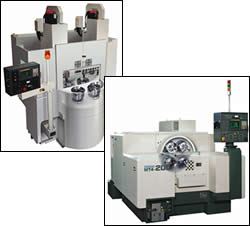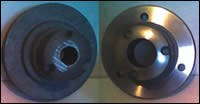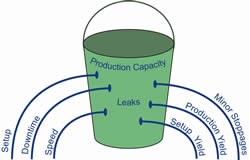When Four Spindles Make Sense
For the right applications, four-spindle CNC chuckers offer practically zero delay for part loading. That’s because two spindles can be loaded while the other two are making chips.
Share


Hwacheon Machinery America, Inc.
Featured Content
View More



Takumi USA
Featured Content
View More
Autodesk, Inc.
Featured Content
View More

Picture an HMC with pallet-changing capability. Workpieces can be machined on one pallet while another pallet located outside the HMC is prepped for the next machining job. Essentially, the only machining delay occurs when the pallets shuttle to reverse their positions.
Now envision a lathe that has four spindles positioned in a square formation on an indexing carrier drum. The carrier drum functions in much the same way as an HMC’s pallet changer. It locates two of the four spindles within the lathe’s enclosed machining environment to allow turning of two workpieces. Meanwhile, the two spindles positioned outside the machining zone can be loaded manually or via robot or gantry. When turning operations are completed on one pair of spindles, the carrier drum indexes the other two spindles loaded with fresh workpieces into the machining zone. As long as the cycle time for the turning operations is longer than the loading time, the only delay is the seconds it takes to index the spindle carrier drum.
Camloh Machinery Solutions’ Bill Camloh, Jr., cites three advantages to such a turning platform. First, these machines can offer significant part-load time savings. Second, they are particularly effective when cycle times for side-A and side-B operations on a single type of workpiece are imbalanced. Third, machine production is the same whether part loading is performed manually or via automation, so long as turning cycle time is longer than loading time.
Mr. Camloh’s LaFayette, New York, machine tool sales company offers Japanese-made Kitako four-spindle CNC chuckers (Kitako’s parent company is Kitagawa). These machines are imported into the United States by SB Machine Tools (Schaumburg, Illinois). In this article, Mr. Camloh provides more detail about the four-spindle chucker design, as well as an example of how these machines can improve throughput for near-net-shaped or blanked workpieces that have vastly different cycle times for side-A and side-B work.
Four-Spindle Design
The Kitako four-spindle chucker is based on that company’s original three-spindle design. The three spindles on those lathes were commonly used to allow simultaneous roughing, finishing and part loading. The carrier drum had enough space to accommodate a fourth spindle, so the company added that spindle to allow a greater mix of turning scenarios.
The Kitako machines are available in horizontal and vertical spindle orientations. The horizontal models offer chucks ranging in diameter from 4 to 8 inches. Spindles are positioned such that they face the operator as he or she looks at the machine. The vertical models are typically used for large, heavy workpieces and are available in 8- to 15-inch chuck models.
The machines are designed to readily accept automation, either as turnkey units or retrofits to machines installed in the field. Mr. Camloh estimates that 90 percent of the more than 500 machines that have been sold in the United States include automation (he notes that every machine is purchased with automation in Japan). There are two automation platforms—gantry load or multi-axis robot. A gantry loader (with one, two or three arms) is most commonly installed as an engineered package. Dual, independent gantry arms are also available, as are machine- and floor-mounted robots. These part loading systems can also have air gages or probes installed to enable part measurement while unloading the part. That information is fed to the control to automatically adapt to wearing tools, for example. (The link to an online video showing a four-spindle machine with gantry loader can be found in the Learn More box at the end of this article.)
Each of the two spindles in the machining zone is served by its own turret or gang tools. Gang tooling is typically used for very high work volumes. The standard turret has 8 stations, while 10-station turrets allow as many as 5 positions to have live tooling. The decision to use live tooling should be based upon the amount of cycle time required for drilling, tapping and other such operations. If that time is a significant portion of the total cycle time, it may make more sense to perform non-turning operations on a mill, Mr. Camloh says. That’s because the value of the minimized part loading time is diminished. For instance, taking 15 seconds to load a new part is significant when the overall cycle time is relatively small. However, it’s not as significant with long cycle times that include live-tooling operations.
Typical Turning Applications
Four-spindle chuckers are not necessarily appropriate only for high-volume jobs. Mr. Camloh says that the chuckers are being used for part runs of 500 or more. The most common machining scenarios are:
- One turning operation for one part type in all four chucks (AA/AA)
- Simultaneously turning side A of a part in one chuck and side B of the same part type in another chuck (AB/AB)
- Simultaneously turning side A of one part type in two chucks followed by side B of that same part type in the other two chucks (AA/BB)
The four-spindle design is particularly effective for the last case listed above, especially when there is a relatively large cycle time imbalance between side-A and side-B operations. Consider the example shown in Table 1 on page 100 of a cast iron housing. These parts have a side-A cycle time of 59 seconds for turning, boring and off-center drilling, and a side-B cycle time of 23 seconds for boring and facing. Loading time is 12 seconds. If a twin-spindle lathe were turning side A of that part in one spindle and side B of the same part type in its other spindle, then the side B spindle would sit idle for 36 seconds. It would have to wait for the other spindle to complete the longer 59-second operation. In this example, one part would be completed every 71 seconds because the total cycle time is based on the longest operation plus loading time.
On the other hand, when a four-spindle chucker performs AA/BB work, the total cycle time is based on the average of side-A and side-B cycle times. Once side A for two parts is completed, the carrier can index the other two spindles to begin side-B work on two more parts. In this example, two parts are completed every 85 seconds, meaning one part is completed every 42.5 seconds. In addition, spindle utilization of the four-spindle chucker is 98 percent, versus 32 percent for a two-spindle machine.
Related Content
How to Mitigate Risk in Your Manufacturing Process or Design
Use a Failure Mode and Effect Analysis (FMEA) form as a proactive way to evaluate a manufacturing process or design.
Read More4 Rules for Running a Successful Machine Shop
Take time to optimize your shop’s structure to effectively meet demand while causing the least amount of stress in the shop.
Read MoreTips for Designing CNC Programs That Help Operators
The way a G-code program is formatted directly affects the productivity of the CNC people who use them. Design CNC programs that make CNC setup people and operators’ jobs easier.
Read More4 Tips for Staying Profitable in the Face of Change
After more than 40 years in business, this shop has learned how to adapt to stay profitable.
Read MoreRead Next
5 Rules of Thumb for Buying CNC Machine Tools
Use these tips to carefully plan your machine tool purchases and to avoid regretting your decision later.
Read MoreRegistration Now Open for the Precision Machining Technology Show (PMTS) 2025
The precision machining industry’s premier event returns to Cleveland, OH, April 1-3.
Read MoreBuilding Out a Foundation for Student Machinists
Autodesk and Haas have teamed up to produce an introductory course for students that covers the basics of CAD, CAM and CNC while providing them with a portfolio part.
Read More


















.png;maxWidth=150)















.jpg;maxWidth=300;quality=90)




















